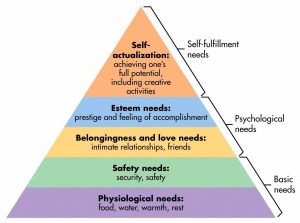If there’s one thing I learned when I became a first-line manager it’s that in life at work, people are driven by different factors. Driving employee engagement through Maslow’s hierarchy of needs was critical to this lesson.
I’d spent the first few months as a manager assuming that my team was motivated by the same thing I was: the organization’s mission of public service. I soon learned that creativity and job growth were among the top motivators for my team. This realization came in the form of a lesson. Despite my best intentions, I was neglecting the needs of my team and oblivious to what they cared about most. My team slowly became demotivated and their performance declined.
Needless to say, this ultimately reflected on me as a manager, and these first six months proved that managing my team was as much about each of them as it was about my abilities and management style.
As managers, new and experienced, we should constantly be asking what drives our employees to work: Do they want a higher salary and better benefits? Do they want opportunities for growth and advancement? More responsibility and creative license? Or something else entirely?
We’ve all heard of Abraham Maslow’s hierarchy of needs. Maslow was a psychologist whose theory argued that an individual’s psychological health needs must be fulfilled in order of priority – starting from basic needs to self-actualization. Fundamentally, people cannot reach the next tier of the pyramid without fulfillment of the previous tier. From basic needs such as earning money to psychological needs, like valuable work relationships, recognition and workplace accomplishments. Lastly, there’s self-actualization – the individual zenith.
Maslow Hierarchy of Needs Pyramid

Maslow Remixed for Employee Engagement – “Mount Maslow”
Let’s think about the pyramid as a mountain. Envision climbing the mountain individually and as a team. Understand where your employees are on the mountain and determine what you need to provide for the individuals to unlock their true potential and ascend the summit.
The Levels of Mount Maslow
Base Tier – Basic Needs of Survival & Safety
At this tier, survival is the essential need and motivation for employees. Employees need a job that pays the bills, combined with some assurance that their job is stable. Employees in this stage most likely view their position as a job, not a career. It is difficult to ask employees to leave this stage when they don’t receive competitive pay and benefits. As a manager, your goal is to get your employees out of this tier into the more productive tiers, where creativity and high-performance live. Focus on the the potential that their current job offers.
Middle Tier – Psychological Needs
Humans are social creatures. We want to connect with others and to be liked. Employees want to be part of a team, be well-respected and connected to the mission of the company or agency. Employees in this stage are working their way to the top, but for most, this is not their final destination. Managers should foster quality team building and encourage group engagement.
Summit – Self-Fulfillment
At the summit, employees have a high level of ambition and want to grow beyond measure. Employees want to stretch their creative muscles and be the best version of themselves. Managers should encourage their employees to achieve this level as their professional goal.
Climbing Mount Maslow
Let’s climb to the top of Mount Maslow. Here are some steps to reach the summit.
Know where your team is on the journey. Are some team members struggling to get to the next level? Have some become complacent? Having this information will help you craft a tailored plan.
Eliminate job dissatisfaction. Remove the baggage that’s preventing your employees from reaching their personal best: things like wage inequality, team issues, job security issues and outdated policies. Prioritize your efforts based on your team’s location on Mount Maslow.
Create the right conditions for job satisfaction. Identify and create the right conditions for employees to jump to the next tier. For example, create opportunities for advancement, increase responsibility to fit strengths and individual interests. It is in this environment that your employees will propel themselves to the next higher echelon.
Know that progress isn’t permanent. Unfortunately, progress is not linear. It’s more like the game Chutes and Ladders. Someone may progress from the bottom to the summit, but regress based on evolving circumstances. Reassess your team’s progress and make changes to your plan as needed.
Conclusion
Everyone is driven to go to work, but we all have different reasons why work motivates us. By having an understanding of what drives your employees, you can help them ascend to their individual zenith and unlock their full work potential.
What drives you to come to work? Where are you or your team on Mount Maslow?
For more reading on Maslow’s hierarchy of needs as well as employee engagement, check out these articles:
3 Approaches to Better Employee Engagement
Driving Employee Engagement in the Public Sector
Citizens’ Maslow Hierarchy of Needs
Fredy Diaz is part of the GovLoop Featured Contributor program, where we feature articles by government voices from all across the country (and world!). To see more Featured Contributor posts, click here.





Maslow’s theory make some sense. However, some thought leaders are saying we have Maslow’s pyramid backwards. They claim that basic inner needs have to met first that are more important than food and shelter. Love, truth and compassion are more important than paying the rent and keeping the car payments up. If our life is consumed by taking care of basic needs, we tend to put off the more important notions of loving our neighbor as our self.
Maslow’s Hierarchy of Needs is biased toward the poor and less fortunate who struggle with basic needs their entire lives. Based on your interpretation of the pyramid, these unfortunate souls will never move up the pyramid.